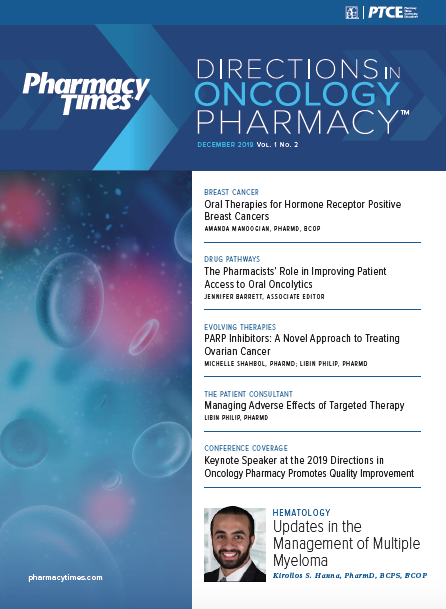
Patient Activation, Good Communication, and Shared Decision Making Are Critical in Chronic Lymphocytic Leukemia
The second session at the 2019 Directions in Oncology Pharmacy™ conference discussed emerging clinical options for patients who have chronic lymphocytic leukemia (CLL), with a special emphasis on the pharmacist’s role.
The second session at the 2019 Directions in Oncology Pharmacy™ conference discussed emerging clinical options for patients who have chronic lymphocytic leukemia (CLL), with a special emphasis on the pharmacist’s role. Alison Duffy, PharmD, BCOP, of the Department of Pharmacy Practice in Science at the School of Pharmacy at the University of Maryland, presented this session to an interested, involved audience. Her emphasis was that therapeutic options rest entirely on patient and disease-specific factors, and the oncology treatment team must craft treatment strategies with this concept in mind.
CLL represents 1.2% of all new cancer cases, and it is the most common type of leukemia in developed nations. Although approximately 4000 Americans died of this cancer in 2019, death rates have fallen an average of 2.8% annually since 2006. Dr Duffy reviewed diagnosis and staging, prognostic factors, and patient factors.
Over the past 5 years, the way in which oncology teams approach CLL has changed. Therapy selection and patient management have become more complex, and the number and type of agents used to treat CLL have expanded. Traditionally, chlorambucil has been the chemotherapy of choice. Today, patients can be treated with immunotherapy, chemoimmunotherapy, small molecule inhibitors, and combinations of these approaches. In addition, oncologists are investigating different sequences and different treatment durations to see whether changing each might improve prognosis. These changes reflect the fact that there is a better understanding of CLL’s biology and prognostic factors.
Dr Duffy moved on to discuss the 2019 National Comprehensive Cancer Network guidelines for first-line therapies, discussing various regimens and the agents they employ. She stressed that there is no 1-size-fits-all approach. Ultimately, most patients will be treated with ibrutinib. The use of combination approaches is evolving, including use of an oral small molecule inhibitor with immunotherapy or use of 2 oral small molecule inhibitors.
Oncology pharmacists are continuously intrigued by and watching for new medications in the pipeline, and Dr Duffy did not disappoint in this regard. She described the Bruton tyrosine kinase inhibitors, the selective spleen tyrosine kinase inhibitor, an anti-onco-embryonic ROR1 monoclonal antibody, a second-generation P13K inhibitor, and a CD19-targeted CAR T cell approach. All are currently being evaluated in clinical trials.
As has traditionally been the case, the pharmacist’s role includes watching for drug interactions and administration barriers, antimicrobial prophylaxis and selection of appropriate therapy when patients develop infectious complications, and adverse effect management. Emerging and very important roles include multidisciplinary collaboration, patient activation and communication, and help with financial barriers and medication access. She addressed each of these roles individually, augmenting pharmacists’ knowledge with some well-designed tables and charts to help them understand current thinking.
Dr Duffy discussed managing toxicities that are likely to be troublesome for each of the agents. Among the various adverse effects that patients are apt to experience are headache, atrial flutter and fibrillation, hepatotoxicity, diarrhea and colitis, intestinal perforation, infection, pneumonitis, severe cutaneous reactions, and hematologic complications. For some of the agents used for CLL, such as venetoclax, toxicity management is quite complicated and may include gradual dose increases, dose interruptions, and monitoring for tumor lysis syndrome.
One interesting section of her presentation covered barriers to medication persistence. Ideally, patients with CLL will continue their therapy until they achieve a complete or maximal benefit. She indicated that many patients experience severe or intolerable adverse effects and must stop their medications. She underscored that nonadherence has tremendous repercussions on treatment effectiveness. One approach to prevent nonadherence is to engage patients in shared decision making based on the patient preferences, medical evidence, and clinical judgment. The term patient activation means that patients understand completely and are moved to adhere to their treatment plans with concurrent improved patient satisfaction and lower cost of care.
Pharmacists can lead oral chemotherapy management and have done so in a number of institutions. Some research indicates that patient knowledge and adherence rates improve and time to access medication decreases. Pharmacists also handily identify common adverse drug effects and laboratory monitoring aberrations. Dr Duffy emphasized that pharmacists who have specialized training are uniquely positioned to improve communication, patient activation, and shared decision making for patients with CLL.

2 Commerce Drive
Cranbury, NJ 08512
All rights reserved.